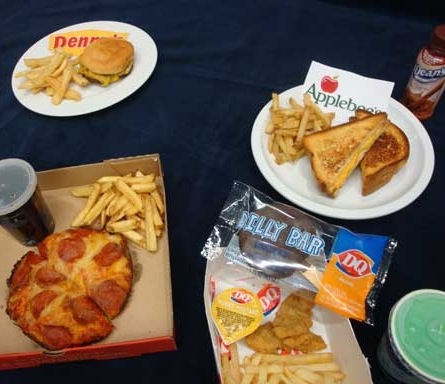
About 97% of kids’ meals sold at restaurants around the country fail to meet the health and nutrition standards defined by the CSPI, or Center for Science in the Public Interest, according to a study by this same organization. The group analyzed almost 3,500 meals from more than 40 chain restaurants around the country, many of which have recently attempted to amp up the nutritional value of their kids’ meals, in coming to their conclusions. Just as a few examples, the CSPI found that 73% of the meals came with french fries, 78% came with a sugar-sweetened beverage, and over 50% were in excess of 600 calories.
Based on the American Heart Associations recommendations for a female aged 4-8, one 600-calorie meal would account for half of the child’s recommended daily intake.
What Makes a Kids’ Meal Healthy?
In order for the CSPI to consider a kids’ meal “healthy,” it must contain:
- Less than 430 total calories
- Less than 35% calories from fat
- Less than 10% calories from trans and saturated fats
- Less than 35% added sugar by weight
- Less than 770 mg of sodium
- A half-serving of veggies or fruit, or;
- At least 51% whole grain, or;
- A sufficient amount of fiber or vitamins
Interestingly, the National Restaurant Association (which advocates for the interests of restaurants) has very similar standards for kids’ meals, albeit with more lenient calorie restrictions. Despite these guidelines, most kids’ meals obviously fail to meet nutritional standards.
The Worst of the Worst
One of the most unhealthy meals tested during the study was the grilled-cheese sandwich with chocolate milk and french fries from Applebee’s, which weighed in at 62 grams of fat, 2,340 mg of sodium and 1,210 calories. The pepperoni pizza with soda and fries from Chili’s was nearly as bad at 45 grams of fat, 2,020 mg of sodium and 1,010 calories. Finally, the chicken strips meal from Dairy Queen, which includes french fries, dipping sauce, an ice cream bar and a frozen drink, included 1,730 mg of sodium, 45 grams of fat and 1,030 calories. All three of these meals have too much sodium, fat and calories for an adult, let alone a young child ordering off the kids’ menu.
At Carl’s Jr., Popeyes and 17 other chain restaurants, literally none of the kids’ meals fell within the CSPI’s guidelines.
Margo Wootan, one of the lead researchers behind the study, said that many chain restaurants appear to be “stuck in a time warp,” improving the nutritional value, quality and freshness of their adult meals while still basing kids’ meals on high-fat, high-calorie, low-nutrition standbys like soda pop, french fries, mac and cheese, hamburgers and fried chicken nuggets.
Slow but Steady Improvements to Kids’ Meal Nutrition
Although 3% is obviously a terrible batting average when it comes to chain restaurants providing nutritious meals to kids, the figure has actually improved significantly in recent years as it stood at just 1% in 2008. In that same year, only 15% of tested meals met the CSPI’s sodium guidelines. That percentage was up to 34% as of 2012.
The CSPI says that restaurants could make a few simple changes in order to make kids’ meals healthier, such as getting rid of sweetened beverages, making fruit and veggies the default side dish instead of chips or french fries, and offering additional whole-grain choices instead of simple carbs like white bread and enriched pasta.
The Bottom Line
The vast majority of kids’ meals served by chain restaurants have excessive levels of fat, sodium and calories but lack real nutrition, according to a recent study by the Center for Science in the Public Interest.













